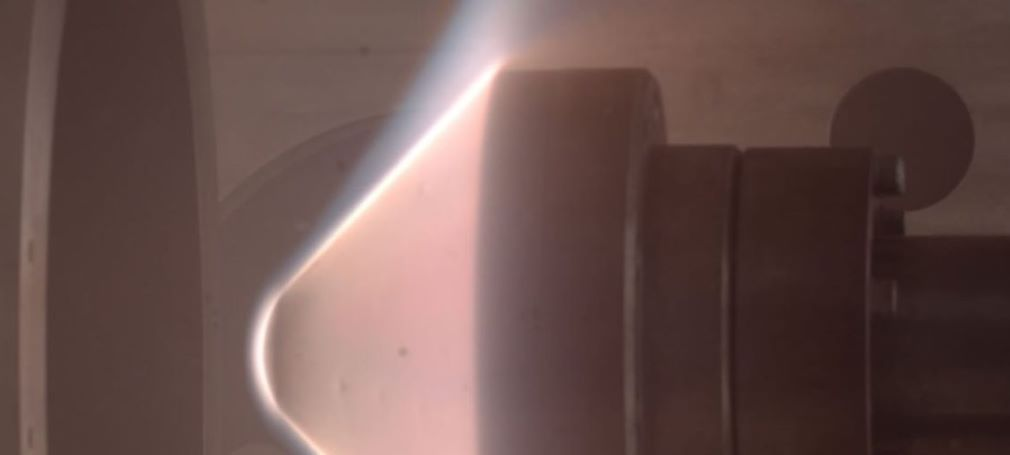Speaker
Description
1 Background of the study
Mars has been the major focus of space exploration and interplanetary travel next only to
Earth. The current design process of thermal protection systems for Mars atmospheric
entry has large tolerances and uncertainities, which result an the excessive mass of heat
shield. One major contributing factor to the uncertainties is the lack of understanding of
backshell radiative heating. Mars’ atmosphere is 95.7% CO2, 2.7% N2 and 1.6% Ar by
volume. In the later parts of the trajectory, closer to the surface of the planet, infrared
radiative heating due to CO2 is a major contributor towards total radiative heating. The
conditions here have a relatively low speed (3-5 km/s) of the spacecraft and a higher
atmospheric density. These conditions induce recombination of the dissociated CO2 in the
bow shock, resulting in its increased number density along the shoulder and the backshell
of the spacecraft. Hence, the total radiative heating here is dominated by radiation due to
vibrationally excited recombined CO2. With future missions to Mars most likely being
low speed, human crewed spacecraft, it is crucial to design a safe and efficient spacecraft
through better understanding the phenomena taking place in the expanding region.
Due to the limited available literature on the experimental validation of CO2 in the
expanding recombining flows under a non-equilibrium regime, the contribution of CO2
towards total radiative heating is not fully understood. Expansion tubes offer a powerful
tool for generating the real flight aerothermodynamics experienced during planetary entry.
The experimental data generated pertaining to such conditions can contribute towards the
comprehension of the phenomena taking place in the shock layer around the spacecraft
including the radiative heating. This can lead to a reduction in the uncertainties in the
modeling.
The goal of this study is to simulate and characterise CO2 recombination in the
conditions representative of Mars low velocity and high density atmospheric entry. The
experimental data is taken in UQ’s X2 expansion tube. Midwave infrared emission
spectroscopy was used to capture and quantify the 4.3 μm band of CO2 on a scaled wedge
model. To characterise the CO2 recombination in expanding flows, a 15 species model is
developed and added to the Eilmer4 database. The species included are CO2, CO, O2,
O, N2, NO, N, C, O, C2, CN, C+, O+, C+, e– . Cruden (2018) proposed the most up
to date reaction scheme relevant to Mars atmospheric entry. In this work, Park’s and
Cruden’s chemical kinetics models are used to predict the non-equilibrium shock layer in
the experiments. The numerically predicted radiation will be compared with the measured
data for validation purposes. NASA’s radiation modeling code NEQAIR is used to predict
and validate the radiation for the proposed conditions.
2 Methodology
2.1 Experimental Setup
To simulate the non-equilibrium expanding flows, a 54◦ two-dimensional wedge was used
to generate a strong shock, post shock compression region and expanding region. The
simulated phenomena are representative of the strong bow shock and the corresponding
expansion along the shoulder of a spacecraft making an atmospheric entry. The X2
expansion tube is used to create super-orbital flows representative of a planetary entry.
The conditions were designed to generate a free stream velocity of 4000 m/s, pressure of
400 Pa and density of 2 × 10−3 kg/m3, which is representative of BET (Best Estimated
Trajectory) of the MSL (Mars Science Laboratory) between 80 and 85 seconds.
To capture the 4.3 μm band of CO2, midwave infrared emission spectroscopy was used.
The flow was imaged along a field of view of about 35 mm, which captured the freestream,
post shock compression region, the expansion fan and the post-expansion region. The
imaging system as designed were set to capture the region 4 mm above the shoulder of
the wedge model.
2.2 Flowfield and Radiation Modeling
UQ’s in-house numerical simulation code, Eilmer4 is used to model the flow using the
most updated transport property model and the reaction schemes. The collision integrals’
fit coefficients were generated by curve-fitting the expression proposed by Gupta and Yos
using the data provided by Wright et al. NASA’s radiation modeling code, NEQAIR is
used for radiation modeling.
3 Results
Experimental spectra have been generated and calibrated. The calibrated spectra of both
the conditions showed an increase in the 4.3 μm band radiance in the shoulder region as
compared to the radiance in post shock region, that could be due to recombining CO2.
The authors are working on the validation of the most up-to-date reaction scheme and
transport property model using the data obtained through X2 experimentation using
Eilmer4 and NEQAIR. This will result in the characterisation of CO2 in the expanding
recombining region. The results will be included in the final presentation.
4 Conclusion
The conditions representative of low velocity, high density Mars atmospheric entry were
designed and generated in the X2 expansion tube in a cold driver configuration. Midwave
spectroscopy was used to capture the 4.3 μm band of CO2. The spectra showed an
increased band radiance in the expanding region as compared to post shock region. The
results from the flowfield and radiation modeling will help validate and characterise the
CO2 recombination for our conditions. The results will allow validation of the proposed
numerical scheme
Summary
The conditions representative of low velocity, high density Mars atmospheric entry were
designed and generated in the X2 expansion tube in a cold driver configuration. Midwave
spectroscopy was used to capture the 4.3 μm band of CO 2 . The spectra showed an
increased band radiance in the expanding region as compared to post shock region. The
results from the flowfield and radiation modeling will help validate and characterise the
CO 2 recombination for our conditions. The results will allow validation of the proposed
numerical schemes.

